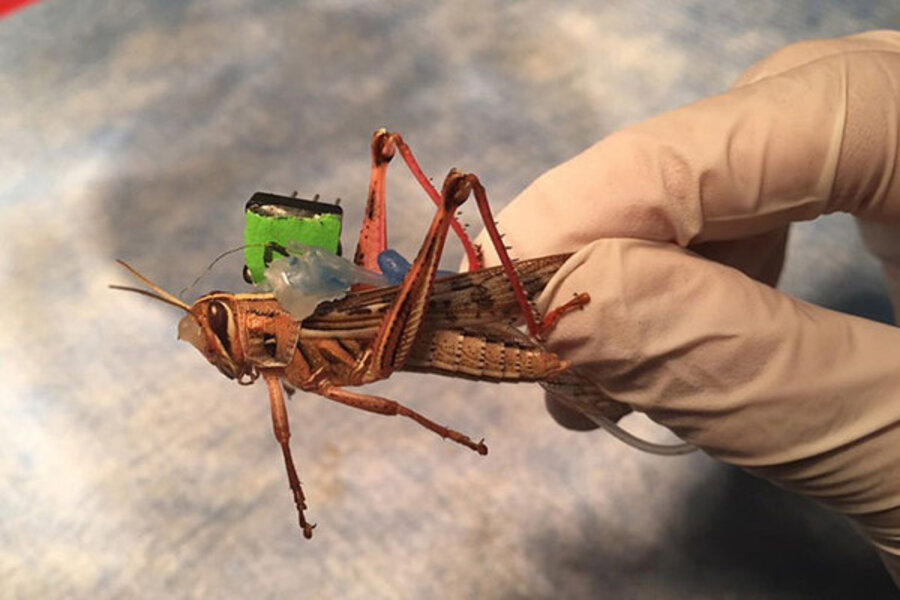US Navy invests $750,000 in bomb-tracking cyborg locusts
Loading...
How’s this for rebranding? The locust, commonly known as a pest and a bad omen, might someday avert disaster.
The Office of Naval Research is awarding Washington University professors a three-year, $750,000 grant to develop bomb-sniffing locusts – a surprising alternative to current explosive detection animals, which include dogs and dolphins.
Why locusts? They have a remarkably sensitive olfactory system, thousands of times more complex than the best chemical detection devices available. So rather than attempt to engineer a similar system biomedical engineer Barani Raman decided to harness the original.
“Why reinvent the wheel? Why not take advantage of the biological solution?” he asked in a press release. “That is the philosophy here. Even the state-of-the-art miniaturized chemical sensing devices have a handful of sensors. On the other hand, if you look at the insect antenna, where their chemical sensors are located, there are several hundreds of thousands of sensors and of a variety of types.”
James Traniello, an insect behavior ecologist at Boston University who is not affiliated with the research, agrees that locusts' sensory abilities combined with their small size could make them a valuable addition to military work.
"I do think that insects could have advantages due to their small size, making them difficult to detect and more effective in entering spatially restrictive areas," says insect behavior ecologist James Traniello in an email to The Christian Science Monitor. "Some insects fly, others walk, each mode of locomotion having potential advantages as detection tools. Some insects are known for their extraordinary chemical sense, ability to be trained to recognize odors and patterns, and other sophisticated cognitive skills. Some have remarkable navigation abilities, and may be able to search, detect, and return."
Dr. Raman, who specializes in biological olfaction, has worked with locusts for years. In previous studies, his team demonstrated that locusts could recognize specific odors even in complex, multi-scent environments.
“It took only a few hundred milliseconds for the locust's brain to begin tracking a novel odor introduced in its surroundings,” Raman told the BBC. “The locusts are processing chemical cues in an extremely rapid fashion.”
Researchers can use locusts to identify chemical traces by surgically implanting sensors in a locust’s brain and decoding the neural activity as it “sniffs.” According to The Washington Post, Raman’s team plans to connect the sensors to a tiny transmitter “backpack,” which would send neural information back to a receiver. An LED light on the receiver would then flash red for explosives detected or green if the coast is clear.
But unsurprisingly, bugs are hard to train. That’s where fellow Professor Srikanth Singamaneni comes in. Dr. Singamaneni, who studies soft nanomaterials at Washington University, will work to create “tattoos” to guide the locusts to their targets. These “tattoos” – actually biocompatible silk attachments – can generate mild heat. By attaching them to locusts’ wings and adjusting the heat on either side, researchers could steer their insect by remote control.
The experimental use of live animals also comes with thorny ethical questions.
The idea of living, remote-controlled insects was explored in 2013 when an educational company called BackyardBrains began marketing commercially available “cyborg cockroaches.” RoboRoach is a “do-it-yourself” surgical kit that allows students to control the movement of a cockroach subject via smartphone app. While some praised the product for encouraging interest in neuroscience, others considered it inhumane, Science Magazine reported. A year later, PETA successfully petitioned to have the app removed from the Google Play store.
This isn’t the first time the US military has enlisted help from the animal world. Rats, dogs, dolphins and elephants have all been trained to detect explosives. Amid promises to wean off the practice, many military branches still use pigs in combat training – by injuring them and requiring soldiers to provide rapid care. Despite advances in technology, some still favor using real biological systems over engineered solutions.
“The canine olfactory system still remains the state-of-the-art sensing system for many engineering applications, including homeland security and medical diagnosis,” Raman said in a press release. “However, the difficulty and the time necessary to train and condition these animals, combined with lack of robust decoding procedures to extract the relevant chemical sending information from the biological systems, pose a significant challenge.”
Locusts may be more suitable for the warfare in other ways.
While the sentience of insects is still being studied – last year, Caltech researchers found that flies experienced "fear-like" emotions – the use of bugs on the battlefield will likely prove less controversial than the use of larger animals.
"I assume that if sacrifice is involved, there will be fewer ethical concerns with insects than vertebrates," Boston University's James Traniello says. "There is an overarching concern about using any animal in warfare, although those that are less sentient, like insects, will likely draw less attention."








